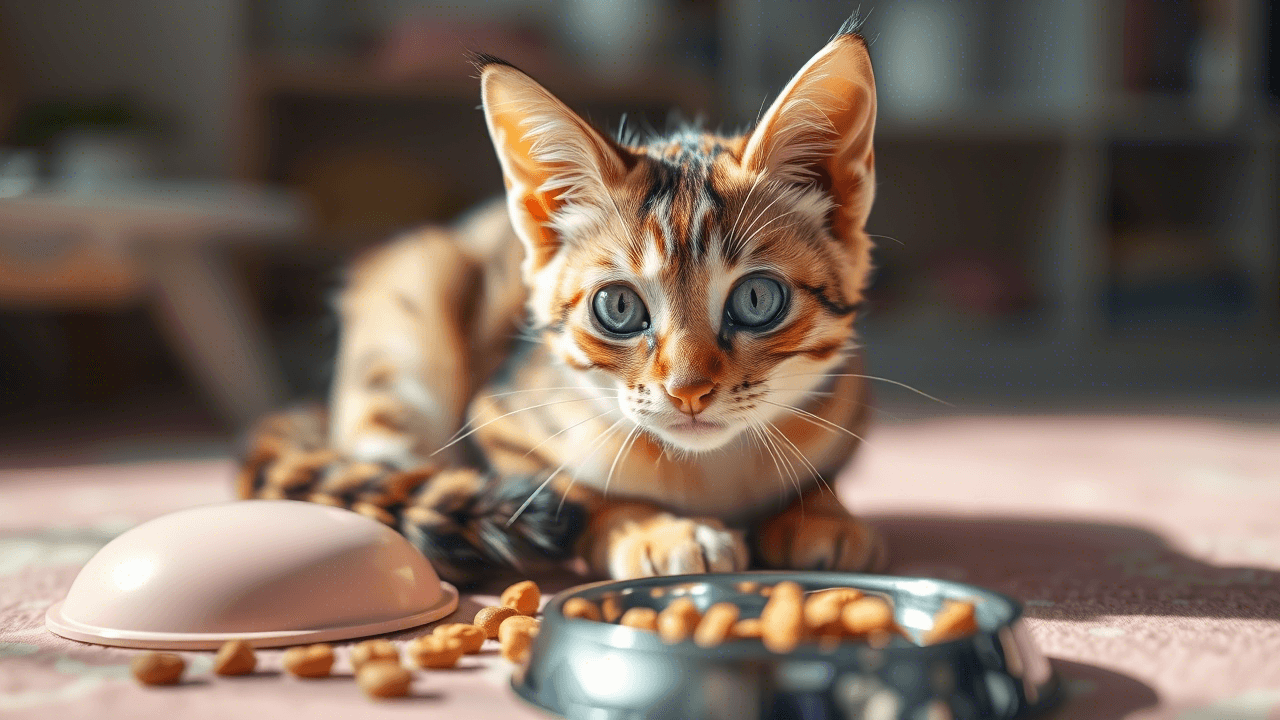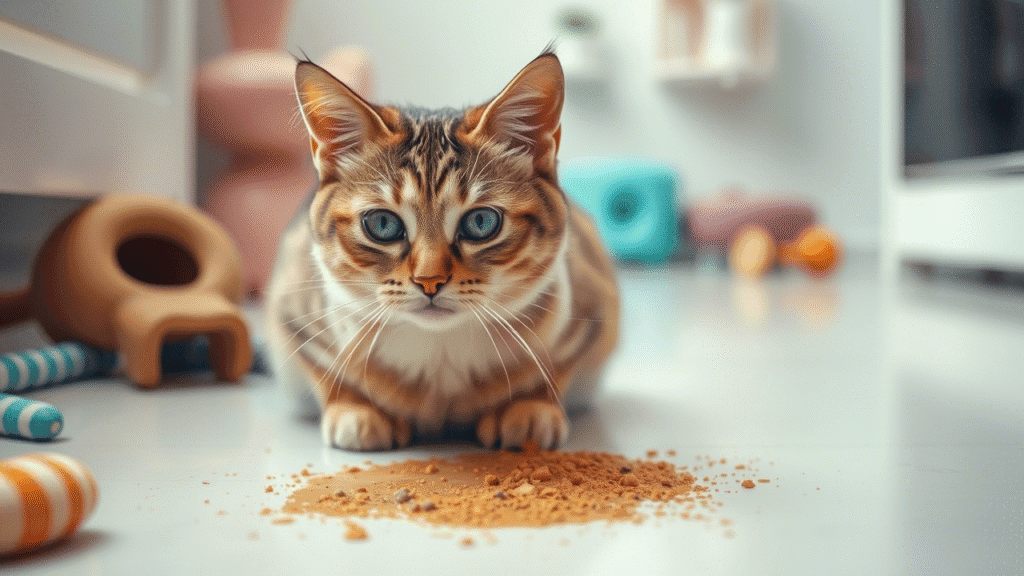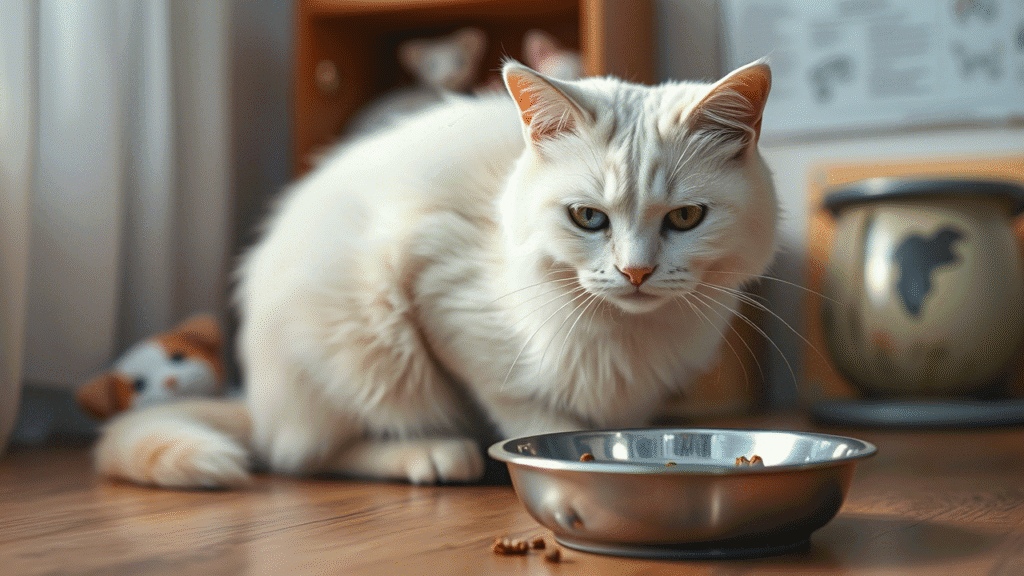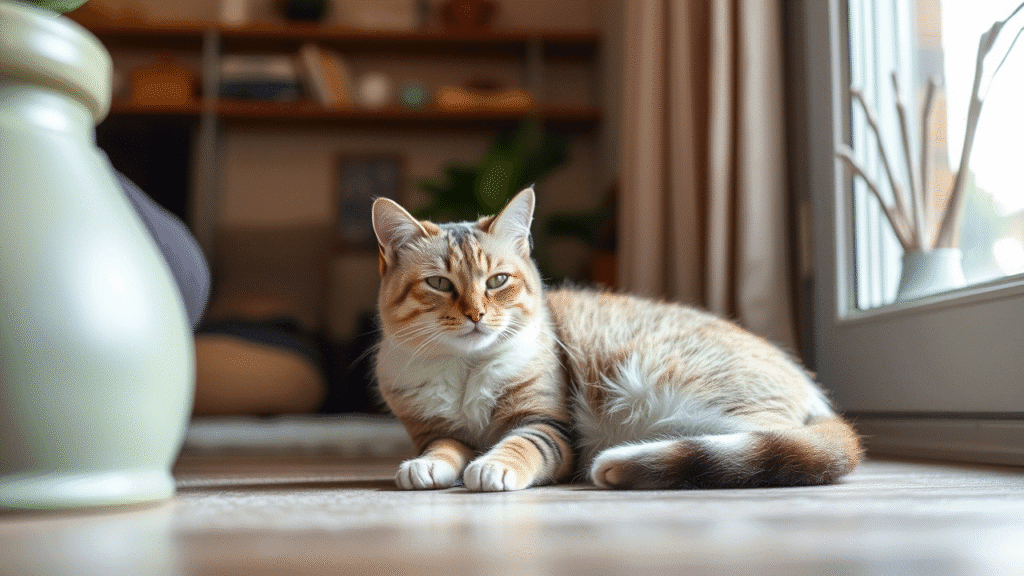
Table of Contents
As a cat parent, few things are as concerning as watching your feline friend enjoy a meal only to vomit it back up minutes later. The sight of undigested food on your freshly cleaned floor isn’t just frustrating—it can be genuinely worrying. If your cat throws up after eating regularly, you’re certainly not alone. This common feline behavior affects cats of all ages and breeds, leaving many pet owners puzzled and concerned about their cat’s health.
Understanding why cats throw up after eating is crucial for addressing the issue effectively and ensuring your furry companion’s wellbeing. In this comprehensive guide, we’ll explore the numerous reasons behind post-meal vomiting in cats, differentiate between normal regurgitation and concerning symptoms, and provide practical solutions to help your cat keep their meals down.
The Difference Between Vomiting and Regurgitation
Before diving into the causes, it’s important to distinguish between true vomiting and regurgitation, as they stem from different issues and require different approaches.
Regurgitation: The Passive Process
Regurgitation occurs when undigested food is expelled from the esophagus shortly after eating. This process is typically passive, happening without much warning or effort from your cat. The key characteristics of regurgitation include:
- Occurs within minutes of eating
- Expelled food appears undigested and may be tube-shaped
- Often happens without warning or apparent discomfort
- Little to no abdominal heaving or retching
- Food may be covered in mucus but not bile
Regurgitation typically indicates an issue with the esophagus or the act of swallowing rather than a problem with digestion itself.
Vomiting: The Active Process
True vomiting is an active process that originates from the stomach or upper intestines. When a cat vomits, you’ll notice:
- Active retching and abdominal contractions
- Occurs anywhere from minutes to hours after eating
- Food appears partially digested
- May contain yellow bile or foam
- Often preceded by signs of nausea (drooling, excessive swallowing, licking lips)
Vomiting involves the stimulation of the vomiting center in the brain and suggests problems with digestion, the stomach, or systemic issues affecting the digestive process.
Common Causes of Cats Throwing Up After Eating

1. Eating Too Fast
One of the most common reasons cats throw up after eating is simply consuming their food too quickly. Cats who gobble down their meals risk overwhelming their digestive system, leading to regurgitation shortly after eating. This is particularly common in:
- Cats who feel competitive around other pets
- Those who’ve experienced food scarcity in the past
- Cats with a naturally enthusiastic approach to mealtime
The stomach doesn’t have time to properly accommodate the rapid influx of food, triggering a reflex to expel the excess. In these cases, the regurgitated food often appears in a tubular shape, largely undigested, and happens within minutes of finishing a meal.
2. Hairballs
While hairballs are typically associated with prolonged coughing and hacking, they can sometimes cause vomiting related to meals. As cats groom themselves, they inevitably ingest hair that can accumulate in their digestive tract. When hair combines with food in the stomach, it may trigger the vomiting reflex.
Hairball-related vomiting is more likely to occur in:
- Long-haired breeds like Maine Coons, Persians, or Ragdolls
- Cats during seasonal shedding periods
- Excessive groomers or cats with grooming compulsions
The distinguishing feature of hairball vomiting is the presence of hair in the vomit, often formed into a tubular shape.
3. Food Allergies or Sensitivities
Just like humans, cats can develop allergies or sensitivities to ingredients in their food. These adverse reactions can cause inflammation in the digestive tract, leading to vomiting after meals. Common food allergens for cats include:
- Beef
- Dairy products
- Fish
- Chicken
- Wheat or gluten
- Corn
- Artificial additives and preservatives
Food allergies often develop over time, so a cat may suddenly start reacting to a food they’ve eaten without problems for years. Besides vomiting, food allergies might also cause skin irritations, excessive grooming, or changes in stool consistency.
4. Changes in Diet
Cats are notorious creatures of habit with sensitive digestive systems. Abrupt changes to their diet—whether switching brands, formulations, or even just flavors—can upset their stomach and lead to post-meal vomiting. Their digestive enzymes and gut bacteria are adapted to process specific nutrients, and sudden changes don’t allow their system time to adjust properly.
This type of vomiting usually resolves within a few days as the cat’s digestive system adapts to the new food, provided the transition is managed carefully going forward.
5. Gastritis and Digestive Disorders
Inflammation of the stomach lining, known as gastritis, can cause cats to vomit after eating. This condition may be acute (coming on suddenly) or chronic (developing over time). Gastritis can be caused by:
- Bacterial or viral infections
- Parasites
- Ingestion of irritants or toxins
- Systemic diseases affecting digestion
- Stress or anxiety
Other digestive disorders like inflammatory bowel disease (IBD), gastrointestinal ulcers, or intestinal blockages can also lead to post-meal vomiting. These conditions typically involve additional symptoms beyond just vomiting after eating.

6. Medical Conditions
Several underlying medical conditions can manifest as vomiting after meals:
Pancreatitis
Inflammation of the pancreas interferes with the release of digestive enzymes, making food digestion difficult and potentially causing vomiting shortly after eating.
Kidney Disease
As kidney function declines, toxins build up in the bloodstream that can trigger nausea and vomiting, often occurring in relation to meals.
Hyperthyroidism
This common condition in older cats speeds up metabolism and can cause numerous digestive issues, including post-meal vomiting.
Intestinal Parasites
Worms and other parasites can irritate the digestive tract, leading to inflammation and vomiting after eating.
7. Foreign Objects
Cats are curious creatures that sometimes ingest non-food items like string, plastic, small toys, or plant material. These objects can partially obstruct the digestive tract, allowing food to pass initially but triggering vomiting as the stomach attempts to process the meal.
Foreign body obstructions are particularly dangerous and require immediate veterinary attention, especially if:
- Vomiting is persistent
- Your cat shows signs of pain
- There’s a complete loss of appetite
- The abdomen appears bloated or tender
Prevention Strategies for Post-Meal Vomiting
Now that we understand the common causes, let’s explore effective ways to prevent your cat from throwing up after eating.
Slow Down Rapid Eaters
If your cat eats too quickly, implementing strategies to slow their pace can dramatically reduce post-meal regurgitation:
- Use puzzle feeders or slow-feed bowls with built-in obstacles
- Divide meals into smaller, more frequent portions throughout the day
- Place a clean golf ball or similar-sized object in the center of their regular bowl (for large enough bowls where the ball can’t be swallowed)
- Spread kibble across a clean cookie sheet instead of piling it in a bowl
- Consider automated feeders that dispense small amounts at set intervals
Many cat parents report significant improvement simply by addressing rapid eating, making this an excellent first step.
Manage Hairballs Proactively

Regular grooming can significantly reduce hairball-related vomiting:
- Brush your cat daily, especially long-haired breeds
- Consider professional grooming services for cats who don’t tolerate home brushing
- Provide specialized “hairball formula” foods with added fiber to help hair pass through the digestive tract
- Use veterinarian-approved hairball remedies or supplements that lubricate the digestive tract
These preventive measures are particularly important during seasonal shedding periods when hairball issues tend to increase.
Identify and Eliminate Food Sensitivities
If you suspect food allergies or sensitivities:
- Work with your veterinarian to conduct an elimination diet trial
- Consider switching to a limited-ingredient diet with novel protein sources
- Look for hypoallergenic formulations designed for sensitive cats
- Gradually transition to new foods over 7-10 days
- Keep a food journal tracking what your cat eats and any subsequent vomiting episodes
Finding the right food may require patience, but it can completely resolve vomiting in cats with food sensitivities.
Make Dietary Changes Gradually
When changing your cat’s food:
- Mix old and new food together, gradually increasing the proportion of new food over 1-2 weeks
- Start with 75% old food and 25% new food for the first few days
- Move to a 50/50 mix for several more days
- Continue with 25% old food and 75% new food
- Finally transition to 100% new food
This gradual approach gives the digestive system time to adjust and reduces the likelihood of vomiting.
Proper Feeding Schedule and Environment
Create optimal conditions for healthy digestion:
- Feed adult cats twice daily at consistent times
- Provide meals in a quiet, low-stress environment
- Use elevated food dishes for older cats or those with certain health conditions
- Keep food and water dishes separated, as some cats prefer not to drink near their food
- Ensure each cat in multi-cat households has their own feeding space to prevent competitive eating
When to See a Veterinarian

While occasional regurgitation might not be cause for alarm, certain situations warrant professional attention. Contact your veterinarian if:
- Vomiting occurs multiple times in 24 hours
- Vomiting persists for more than two days
- Your cat shows additional symptoms like lethargy, diarrhea, or decreased appetite
- There’s blood in the vomit
- Your cat appears to be in pain
- Your cat is losing weight
- Vomiting seems to be getting worse over time
Early intervention often leads to better outcomes and can prevent more serious complications. Your veterinarian may recommend diagnostic tests like bloodwork, ultrasound, or X-rays to determine the underlying cause of chronic vomiting.
Long-term Management for Cats Who Vomit After Eating
For cats with chronic post-meal vomiting, long-term management strategies may include:
- Prescription diets formulated for digestive sensitivity
- Regular preventive care to address underlying conditions
- Anti-nausea medications when necessary
- Probiotics to support healthy gut bacteria
- Stress reduction techniques for anxiety-related digestive issues
- Regular weight monitoring to ensure proper nutrition despite occasional vomiting
Working closely with your veterinarian to develop a personalized management plan gives your cat the best chance of comfortable, vomit-free dining.
Conclusion
When your cat throws up after eating, it can be concerning, but understanding the potential causes puts you in a better position to address the issue effectively. In many cases, simple adjustments to feeding habits—like slowing down fast eaters or making gradual food transitions—can resolve the problem without medical intervention.
However, persistent vomiting, especially when accompanied by other symptoms, should never be ignored. Your veterinarian is your best partner in determining whether your cat’s post-meal vomiting indicates a serious condition or is simply a manageable quirk of feline digestion.
By implementing the prevention strategies outlined in this guide and seeking professional guidance when needed, you can help your cat enjoy their meals without the unpleasant aftermath. Remember that every cat is unique, and finding the right approach may require some trial and error—but your feline friend’s digestive comfort is certainly worth the effort.
Has your cat been experiencing digestive issues? Consider scheduling a wellness check with your veterinarian to rule out underlying health concerns and develop a tailored plan for your furry family member.
Frequently Asked Questions About Cats Throwing Up After Eating
How can I tell if my cat is vomiting or just regurgitating food?
Regurgitation typically happens within minutes of eating and involves the passive expulsion of undigested, tube-shaped food. There’s usually no warning and minimal abdominal contractions. Vomiting, however, involves active retching and heaving, often preceded by signs of nausea like excessive salivation or licking lips. The expelled content is partially digested and may contain bile. Timing also differs—regurgitation happens almost immediately after eating, while vomiting can occur minutes to hours later. Understanding this difference can help determine the underlying cause and appropriate solution.
Is it normal for cats to throw up occasionally after eating?
Occasional regurgitation, perhaps once every few weeks, isn’t usually cause for concern, especially if your cat appears otherwise healthy and active. Some cats, particularly those who eat quickly, may regurgitate more frequently than others. However, regular vomiting after meals—more than once a week—should be investigated. Even if it seems “normal” for your particular cat, frequent vomiting can lead to nutritional deficiencies, esophageal damage, or indicate underlying conditions that would benefit from treatment. When in doubt, consult with your veterinarian.
What’s the best food for cats who frequently vomit after eating?
For cats with sensitive stomachs who vomit after meals, veterinarians often recommend highly digestible, limited-ingredient diets. Foods with novel protein sources (proteins your cat hasn’t eaten before) can help cats with food sensitivities. Grain-free options work well for some cats, while others benefit from specialized “sensitive stomach” formulations with added prebiotics. For fast eaters, wet food may be easier to digest than dry kibble. Some cats do better with smaller, more frequent meals rather than one or two larger ones. Ultimately, finding the right food may require experimentation under veterinary guidance.
Could stress be causing my cat to throw up after eating?
Absolutely. Cats are sensitive creatures, and stress can significantly impact their digestive health. Anxiety can cause increased stomach acid production, altered gut motility, and changes in eating behavior—all potentially leading to post-meal vomiting. Common stressors include changes in routine, moving to a new home, new pets or family members, loud noises, or conflict with other household pets. If stress seems to be the culprit, consider creating a more predictable routine, providing safe hiding spaces, using feline pheromone products, or consulting with a veterinary behaviorist for severe cases.
When is vomiting after eating considered an emergency?
Seek immediate veterinary care if your cat’s vomiting is accompanied by lethargy, persistent diarrhea, blood in the vomit (appearing as red streaks or coffee-ground-like material), signs of pain, inability to keep any food or water down, or suspected ingestion of toxic substances or foreign objects. Kittens and senior cats are particularly vulnerable to dehydration from vomiting, so prompt attention is crucial. Additionally, if vomiting is projectile or occurs with every meal for more than 24 hours, don’t wait to contact your veterinarian, as this could indicate an obstruction or serious illness requiring immediate treatment.
Can hairball remedies help prevent vomiting after eating?
Hairball remedies can be effective for cats whose vomiting is specifically related to hairball formation. These products typically contain lubricants like petroleum jelly or mineral oil that help hair pass through the digestive tract instead of forming balls in the stomach. They’re particularly useful during heavy shedding seasons or for long-haired breeds. However, hairball remedies won’t address other causes of post-meal vomiting such as eating too quickly, food allergies, or medical conditions. If you’re unsure whether hairballs are the primary issue, have your veterinarian examine your cat before relying solely on these products.
Should I change my cat’s diet if they throw up after eating?
Dietary changes may be beneficial if your cat regularly vomits after meals, but approach with caution. First, rule out non-diet causes like eating too quickly or hairballs. If you suspect a food sensitivity, work with your veterinarian to determine which ingredients might be problematic. Never make abrupt diet changes, as this can actually worsen digestive upset. Instead, transition very gradually over 1-2 weeks by mixing increasing amounts of the new food with the old. Some cats benefit from specialized diets with novel proteins, limited ingredients, or specific textures, but finding the right match often requires professional guidance and patience.
Sources
Cornell University College of Veterinary Medicine – Vomiting
American Veterinary Medical Association – Feline Digestive System
Journal of Feline Medicine and Surgery – Food Allergies in Cats
International Cat Care – Feeding Your Cat







